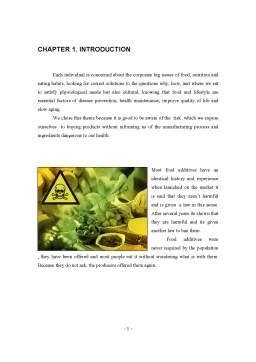Cuprins
- CHAPTER 1. INTRODUCTION - 1 -
- CHAPTER II FOOD ADDITIVES - 2 -
- 2.1 Food additives in Romania. - 4 -
- 2.2 Function of food aditives - 5 -
- 2.3 Safety and regulations - 8 -
- CHAPTER III. STUDY CASE - 10 -
- 3.1 History - 11 -
- Early modern period - 13 -
- 3.2 Classification and types - 14 -
- 3.3 Common Food Aditives - 15 -
- 3.3.1 Additives used in food salt - 15 -
- 3.3.2 Additives used in sugar. - 17 -
- 3.4 Examples - 18 -
- References - 22 -
Extras din proiect
CHAPTER 1. INTRODUCTION
Each individual is concerned about the corporate big issues of food, nutrition and eating habits, looking for correct solutions to the questions why, how, and where we eat to satisfy physiological needs but also cultural, knowing that food and lifestyle are essential factors of disease prevention, health maintenance, improve quality of life and slow aging.
We chose this theme because it is good to be aware of the risk which we expose ourselves to buying products without informing us of the manufacturing process and ingredients dangerous to our health.
Most food additives have an identical history and experience when launched on the market it is said that they aren’t harmful and is given a law in this sense. After several years its shown that they are harmful and its given another law to ban them.
Food additives were never required by the population , they have been offered and most people eat it without wondering what is with them. Because they do not ask, the producers offered them again.
CHAPTER II FOOD ADDITIVES
Food additives are substances added to food to preserve flavor or enhance its taste and appearance. Some additives have been used for centuries; for example, preserving food by pickling (with vinegar), salting, as with bacon, preserving sweets or using sulfur dioxide as in some wines.
With the advent of processed foods in the second half of the 20th century, many more additives have been introduced, of both natural and artificial origin.
The contents of all products, from bread and continuing with concentrated preparations, meats, meat products, especially alcohol and soft drinks, canes of all kind, plants, fruits, grains and vegetables and ending with the trivial GM chewing gum substances are found encroaching on consumer health and even life.
Manufacturing companies from us and from anywhere, which export to our country, and which do not obey regulations, or knowingly exceeding permissible concentrations of harmful substances in products to which we refer.
If some food additives are absolutely prohibited in food and beverages in most EU countries, USA, Australia and countries of the former USSR, here are produced and sold without any restrictions. The idea behind this attack on the human health risk is acceptable.
In other words, if the labels are mentioned and their concentration containe poison, consumers are informed about the risks they run, so they can consume food additives without measure.
Worse is that the authorities do not seem to be concerned about this problem and do not try to end this assault on consumers' health. While the main European Union countries are limited as much as possible from food and drink additives in Romania they can be found in all products.
The main additives that modify food are:
Citric acid (E330) is found in most fruit juices that are in commerce, mustard (as flavor), preserved mushrooms.
Phosphoric acid (E338) produces digestive disorders (indigestion, vomiting, abdominal colic, etc.), is used in cheese dishes.
Aspartame (E951) is a sweetener commonly used and may be the source of over 70 types of disease, according to researchers. It is encountered most often in chewing gum, soft drinks. E951 plays an important role in the onset of brain tumors, multiple sclerosis, malformations and diabetes.
Preview document
Conținut arhivă zip
- Proiect Studiul Marfurilor - Aditivii Alimentari din Condimente.doc























